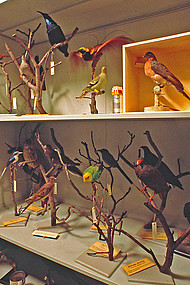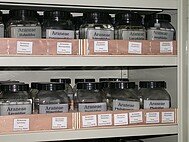Zoological Collections
The zoological collections of today contain only a handful of the specimens dating back to the times of Margravine Caroline Luise and the Museum's first director, Carl Christian Gmelin. Most of the zoological specimens were destroyed by fires during bombings of Karlsruhe, first at the Museum building in 1942, and once again in 1944 at the palace, where the surviving objects had been temporarily moved. The only collection that remained largely intact was that of the molluscs.
The Museum's oldest objects in thevertebrate collection whose history can be traced by old catalogues and labels are priceless items which were acquired or donated in the first half of the 19th century. These include individual skulls (such as that of a Javan tiger) as well as a small collection of exotic birds. Other specimens of now-extinct species — three passenger pigeons, a Carolina parakeet and a Huia — are true treasures of the collection.
The invertebrate collection focuses on arachnids, which were collected in the course of scientific projects in South America and Europe by former department head Prof. Dr. Beck and later the current department head Dr. Höfer. Another wide-ranging collection focuses on samples taken during the many years of research conducted by the soil zoology workgroup – over one million exemplars of soil macrofauna (beetles, arachnids, centipedes and millipedes, snails, isopods) and soil mesofauna (mites and springtails) have been identified.
Other special collections of scientific significance include roundworms (10,000 specimens of nematodes in the collection), molluscs (25,000 specimens), and the internationally unique collection of copepods (19,000 specimens) from the estate of Friedrich Kiefer.
Diversity Workbench databases are used to manage the zoological collections.
The modularized Diversity Workbench also serves as virtual research environment for arachnological data. To mobilize ecological data on spiders from Germany a project funded by DFG ran from 2017-2019, results are presented in a new data portal of Arachnologische Gesellschaft (Arachnological Society) ARAMOB.










